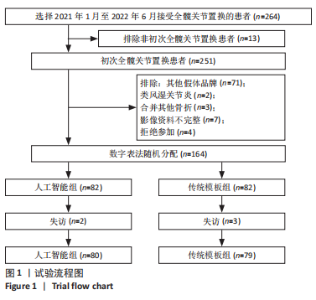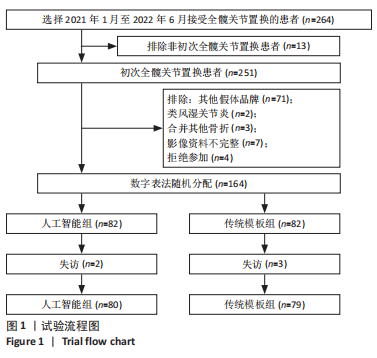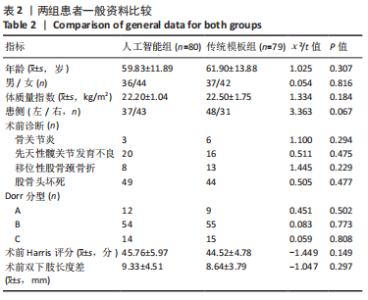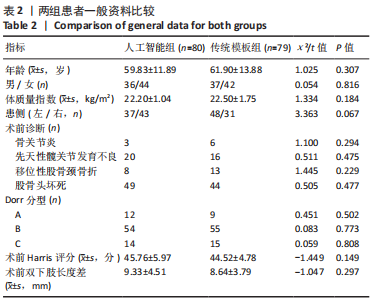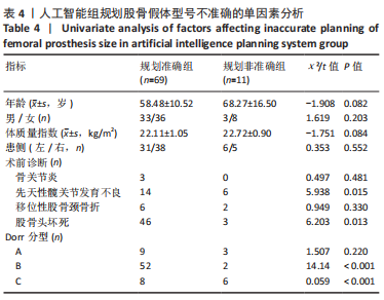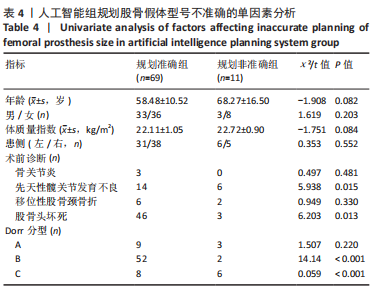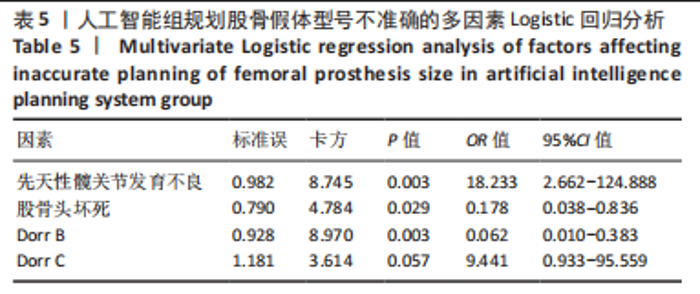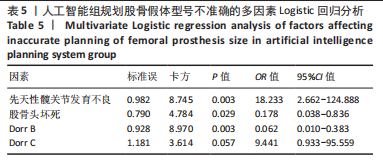Chinese Journal of Tissue Engineering Research ›› 2024, Vol. 28 ›› Issue (12): 1863-1868.doi: 10.12307/2024.026
Previous Articles Next Articles
Accuracy and influencing factor of artificial intelligence planning system in patients undergoing total hip arthroplasty
Zhang Kai1, Guo Zhuotao1, Ma Qiaoqiao1, Zha Guochun2, Guo Kaijin2
- 1Xuzhou Medical University, Xuzhou 221000, Jiangsu Province, China; 2Department of Orthopedics, Affiliated Hospital of Xuzhou Medical University, Xuzhou 221000, Jiangsu Province, China
-
Received:2023-02-09Accepted:2023-03-22Online:2024-04-28Published:2023-08-22 -
Contact:Guo Kaijin, MD, Chief physician, Department of Orthopedics, Affiliated Hospital of Xuzhou Medical University, Xuzhou 221000, Jiangsu Province, China -
About author:Zhang Kai, Master candidate, Physician, Xuzhou Medical University, Xuzhou 221000, Jiangsu Province, China -
Supported by:Young Medical Talent Project of Jiangsu Province, No. QNRC2016800 (to ZGC); General Project of Jiangsu Provincial Health and Family Planning Commission, No. H2017081 (to ZGC)
CLC Number:
Cite this article
Zhang Kai, Guo Zhuotao, Ma Qiaoqiao, Zha Guochun, Guo Kaijin. Accuracy and influencing factor of artificial intelligence planning system in patients undergoing total hip arthroplasty[J]. Chinese Journal of Tissue Engineering Research, 2024, 28(12): 1863-1868.
share this article
Add to citation manager EndNote|Reference Manager|ProCite|BibTeX|RefWorks
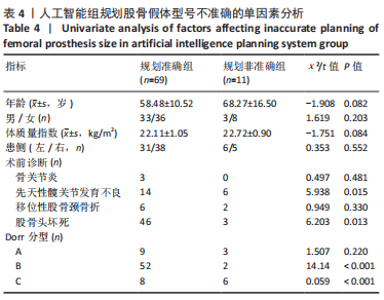
2.5 两组患者术后髋关节功能Harris评分比较 两组患者全部获得随访,人工智能组随访时间平均(13.82±5.06)个月,传统模板组平均(13.61±6.23)个月;末次随访时,人工智能组和传统模板组的Harris评分分别为(92.74±3.08)分、(91.81±3.52)分,上述指标两组比较差异均无显著性意义(P > 0.05)。 2.6 两组患者术后影像学随访结果 所有患者术中均无股骨劈裂骨折发生,至末次随访均未出现假体松动、脱位等情况。人工智能组和传统模板组术后双下肢不等长分别为(3.56±2.32) mm、(3.52±2.41) mm,差异无显著性意义(P > 0.05)。 2.7 AIHIP规划股骨柄与术中选择相差2个型号及以上的单因素分析 人工智能组中69例进入规划准确组,11例进入规划非准确组。单因素分析结果显示,术前诊断为先天性髋关节发育不良、股骨头坏死、Dorr B型及Dorr C型股骨在两组间差异有显著性意义(P < 0.05),见表4。"
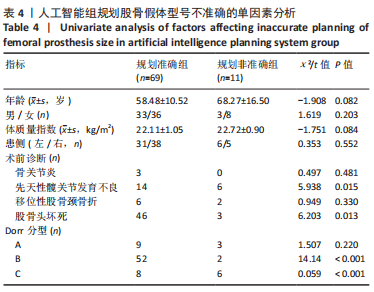
| [1] BRENNEIS M, BRAUN S, VAN DRONGELEN S, et al. Accuracy of Preoperative Templating in Total Hip Arthroplasty With Special Focus on Stem Morphology: A Randomized Comparison Between Common Digital and Three-Dimensional Planning Using Biplanar Radiographs. J Arthroplasty. 2021;36(3):1149-1155. [2] TRIPURANENI KR, ARCHIBECK MJ, JUNICK DW, et al. Common errors in the execution of preoperative templating for primary total hip arthroplasty. J Arthroplasty. 2010;25(8):1235-1239. [3] BISHI H, SMITH JBV, ASOPA V, et al. Comparison of the accuracy of 2D and 3D templating methods for planning primary total hip replacement: a systematic review and meta-analysis. EFORT Open Rev. 2022;7(1):70-83. [4] ADAMCZYK A, LABOUDIE P, NESSEK H, et al. Accuracy of digital templating in uncemented primary total hip arthroplasty: which factors are associated with accuracy of preoperative planning? Hip Int. 2022:11207000221082026. [5] EGGLI S, PISAN M, MÜLLER M. The value of preoperative planning for total hip arthroplasty. J Bone Joint Surg Br. 1998;80(3):382-390. [6] CARTER L, STOVALL D, YOUNG T. Determination of accuracy of preoperative templating of noncemented femoral prostheses. J Arthroplasty. 1995;10(4):507-513. [7] CHEN X, WANG Y, MA R, et al. Validation of CT-Based Three-Dimensional Preoperative Planning in Comparison with Acetate Templating for Primary Total Hip Arthroplasty. Orthop Surg. 2022;14(6):1152-1160. [8] GAMBLE P, DE BEER J, PETRUCCELLI D, et al. The accuracy of digital templating in uncemented total hip arthroplasty. J Arthroplasty. 2010;25(4):529-532. [9] GONZALEZ DELLA VALLE A, COMBA F, TAVERAS N, et al. The utility and precision of analogue and digital preoperative planning for total hip arthroplasty. Int Orthop. 2008;32(3):289-294. [10] 丁冉, 王淇, 刘烨, 等. 人工智能三维术前规划在全髋关节置换术中的应用和准确性分析[J]. 生物骨科材料与临床研究,2022,19(2):33-38. [11] 李兴鑫, 陈施展, 娄延举, 等. 人工智能三维术前规划在全髋关节置换术中的应用[J]. 中国新通信,2022,24(17):104-106. [12] 万超, 董圣杰, 王诗军, 等. 人工智能辅助手术规划系统在个体化全髋关节假体精准植入中的应用[J]. 骨科,2022,13(3):204-211. [13] 胡陈贵. 人工智能辅助全髋关节置换术三维规划系统的应用价值分析[J]. 保健文汇,2022,23(10):185-187. [14] 吴东, 刘星宇, 张逸凌, 等. 人工智能辅助全髋关节置换术三维规划系统的研发及临床应用研究[J]. 中国修复重建外科杂志,2020,34(9):1077-1084. [15] SCHIFFNER E, LATZ D, JUNGBLUTH P, et al. Is computerised 3D templating more accurate than 2D templating to predict size of components in primary total hip arthroplasty? Hip Int. 2019;29(3):270-275. [16] SARIALI E, MAUPRIVEZ R, KHIAMI F, et al. Accuracy of the preoperative planning for cementless total hip arthroplasty. A randomised comparison between three-dimensional computerised planning and conventional templating. Orthop Traumatol Surg Res. 2012;98(2):151-158. [17] REINBACHER P, SMOLLE MA, FRIESENBICHLER J, et al. Pre-operative templating in THA using a short stem system: precision and accuracy of 2D versus 3D planning method. J Orthop Traumatol. 2022;23(1):16. [18] LIM YW, HUDDLESTON JI 3RD, GOODMAN SB, et al. Proximal Femoral Shape Changes the Risk of a Leg Length Discrepancy After Primary Total Hip Arthroplasty. J Arthroplasty. 2018;33(12):3699-3703. [19] CHEN X, LIU X, WANG Y, et al. Development and Validation of an Artificial Intelligence Preoperative Planning System for Total Hip Arthroplasty. Front Med (Lausanne). 2022;9:841202. [20] PETRETTA R, STRELZOW J, OHLY NE, et al. Acetate templating on digital images is more accurate than computer-based templating for total hip arthroplasty. Clin Orthop Relat Res. 2015;473(12):3752-3759. [21] DELLA VALLE A, PADGETT D, SALVATI E. Preoperative planning for primary total hip arthroplasty. J Am Acad Orthop Surg. 2005;13(7):455-462. [22] KRISTOFFERSSON E, OTTEN V, CRNALIC S. The accuracy of digital templating in cementless total hip arthroplasty in dysplastic hips. BMC Musculoskelet Disord. 2021;22(1):942. [23] SERSHON RA, DIAZ A, BOHL DD, et al. Effect of Body Mass Index on Digital Templating for Total Hip Arthroplasty. J Arthroplasty. 2017;32(3):1024-1026. [24] BOESE CK, WILHELM S, HANEDER S, et al. Influence of calibration on digital templating of hip arthroplasty. Int Orthop. 2019;43(8):1799-1805. [25] RAMME AJ, FISHER ND, EGOL J, et al. Scaling Marker Position Determines the Accuracy of Digital Templating for Total Hip Arthroplasty. HSS J. 2018;14(1):55-59. [26] SINCLAIR VF, WILSON J, JAIN NP, et al. Assessment of accuracy of marker ball placement in pre-operative templating for total hip arthroplasty. J Arthroplasty. 2014;29(8):1658-1660. [27] ECKRICH S, NOBLE P, TULLOS H. Effect of rotation on the radiographic appearance of the femoral canal. J Arthroplasty. 1994;9(4):419-426. [28] OSMANI F A, THAKKAR S, RAMME A, et al. Variance in predicted cup size by 2-dimensional vs 3-dimensional computerized tomography-based templating in primary total hip arthroplasty. Arthroplast Today. 2017;3(4):289-293. [29] WAKO Y, NAKAMURA J, MIURA M, et al. Interobserver and Intraobserver Reliability of Three-Dimensional Preoperative Planning Software in Total Hip Arthroplasty. J Arthroplasty. 2018;33(2):601-607. [30] HUO J, HUANG G, HAN D, et al. Value of 3D preoperative planning for primary total hip arthroplasty based on artificial intelligence technology. J Orthop Surg Res. 2021;16(1):156. [31] DING X, ZHANG B, LI W, et al. Value of preoperative three-dimensional planning software (AI-HIP) in primary total hip arthroplasty: a retrospective study. J Int Med Res. 2021;49(11):3000605211058874. [32] ZHAO X, ZHU ZA, ZHAO J, et al. The utility of digital templating in Total Hip Arthroplasty with Crowe type II and III dysplastic hips. Int Orthop. 2011;35(5):631-638. [33] WUESTEMANN T, HOARE SG, PETERSIK A, et al. Bone morphology of the proximal femoral canal: ethnicity related differences and the influence on cementless tapered wedge stem designs. Hip Int. 2021;31(4):482-491. [34] DORR L, FAUGERE M, MACKEL A, et al. Structural and cellular assessment of bone quality of proximal femur. Bone. 1993;14(3):231-242. [35] MAVCIC B, ANTOLIC V. Cementless femoral stem fixation and leg-length discrepancy after total hip arthroplasty in different proximal femoral morphological types. Int Orthop. 2021;45(4):891-896. |
| [1] | Min Meipeng, Wu Jin, URBA RAFI, Zhang Wenjie, Gao Jia, Wang Yunhua, He Bin, Fan Lei. Role and significance of artificial intelligence preoperative planning in total hip arthroplasty [J]. Chinese Journal of Tissue Engineering Research, 2024, 28(9): 1372-1377. |
| [2] | Yu Weijie, Liu Aifeng, Chen Jixin, Guo Tianci, Jia Yizhen, Feng Huichuan, Yang Jialin. Advantages and application strategies of machine learning in diagnosis and treatment of lumbar disc herniation [J]. Chinese Journal of Tissue Engineering Research, 2024, 28(9): 1426-1435. |
| [3] | Ke Yuqi, Chen Changjian, Wu Hao, Zheng Lianjie. Comparison of 12-month follow-up results of primary total hip arthroplasty between modified direct anterior approach and direct anterior approach [J]. Chinese Journal of Tissue Engineering Research, 2023, 27(9): 1377-1382. |
| [4] | Cai Zhihao, Xie Zhaoyong. Femoral neck anteversion measurement assessment: how to establish a unified method and standard [J]. Chinese Journal of Tissue Engineering Research, 2023, 27(9): 1448-1454. |
| [5] | Yan Ruizhong, Li Jiahui, Lin Shuzhong, Wu Xiaogang, Guo Zhijian, Liu Wenqi, Liu Qiang. Effect of pelvic tilt on the stress at the acetabular side in standing position after total hip arthroplasty: finite element analysis [J]. Chinese Journal of Tissue Engineering Research, 2023, 27(36): 5795-5800. |
| [6] | Guo Zhuotao, Zhang Kai, Zha Guochun, Guo Kaijin. A matched controlled trial of lumbar fusion effect on mid-term outcomes after total hip arthroplasty [J]. Chinese Journal of Tissue Engineering Research, 2023, 27(36): 5801-5805. |
| [7] | Li Qizhe, Kong Yao, Fan Jiannan, Wu Yeting, Yang Hua, Xiao Yinlong, Sun Hong. Measurement and clinical significance of acetabular parameters in the Guizhou population [J]. Chinese Journal of Tissue Engineering Research, 2023, 27(36): 5856-5863. |
| [8] | You Aijia, Li Wenjie, Zhou Junli, Li Chun. Systematic evaluation of six dressings on wound safety following total hip and knee arthroplasty [J]. Chinese Journal of Tissue Engineering Research, 2023, 27(3): 486-492. |
| [9] | Zhang Hang, He Qiang, Liu Qing, He Yunli, Wang Tao, Feng Zhe, Zhang Qian, He Sen. Comparative analysis of artificial intelligence and two-dimensional digital template preoperative planning-assisted total hip arthroplasty to predict prosthesis size [J]. Chinese Journal of Tissue Engineering Research, 2023, 27(29): 4620-4627. |
| [10] | Li Junran, Zhai Jingxiu, Zhao Hongbo, Wang Lei, Wang Hongrun, Liang Junsheng, Li Ligeng. Assistance of traction table for total hip arthroplasty through the direct anterior approach for treating femoral neck fracture in the elderly [J]. Chinese Journal of Tissue Engineering Research, 2023, 27(27): 4312-4317. |
| [11] | Ren Yi, Lu Ming, Qin Kunpeng, Zhang Hui, Gao Weilu, Li Yetian, Wang Jun, Yin Li, Yin Zongsheng. OrthoPilot navigation system assisted total hip arthroplasty improves the accuracy and safety of acetabular cup placement [J]. Chinese Journal of Tissue Engineering Research, 2023, 27(27): 4318-4323. |
| [12] | Zhou Hongxing, Zhang Baojian, Yuan Xiangsheng. Recent evaluation of individual biological acetabular cup application in hip revision [J]. Chinese Journal of Tissue Engineering Research, 2023, 27(22): 3521-3525. |
| [13] | Wang Zhangzheng, Mo Liang, Zhou Chi, Liu Yuhao, Yan Hongsong, He Wei. Influence of hip-preservation surgeries on subsequent total hip arthroplasty for osteonecrosis of the femoral head [J]. Chinese Journal of Tissue Engineering Research, 2023, 27(22): 3594-3601. |
| [14] | Zhuang Zhikun, Wu Rongkai, Lin Hanghui, Gong Zhibing, Zhang Qianjin, Wei Qiushi, Zhang Qingwen, Wu Zhaoke. Application of stable and enhanced lined hip joint system in total hip arthroplasty in elderly patients with femoral neck fractures complicated with hemiplegia [J]. Chinese Journal of Tissue Engineering Research, 2022, 26(9): 1429-1433. |
| [15] | Huang Shibo, Xie Hui, Wang Zongpu, Wang Weidan, Qin Kairong, Zhao Dewei. Application of degradable high-purity magnesium screw in the treatment of developmental dysplasia of the hip [J]. Chinese Journal of Tissue Engineering Research, 2022, 26(4): 493-498. |
| Viewed | ||||||
|
Full text |
|
|||||
|
Abstract |
|
|||||
